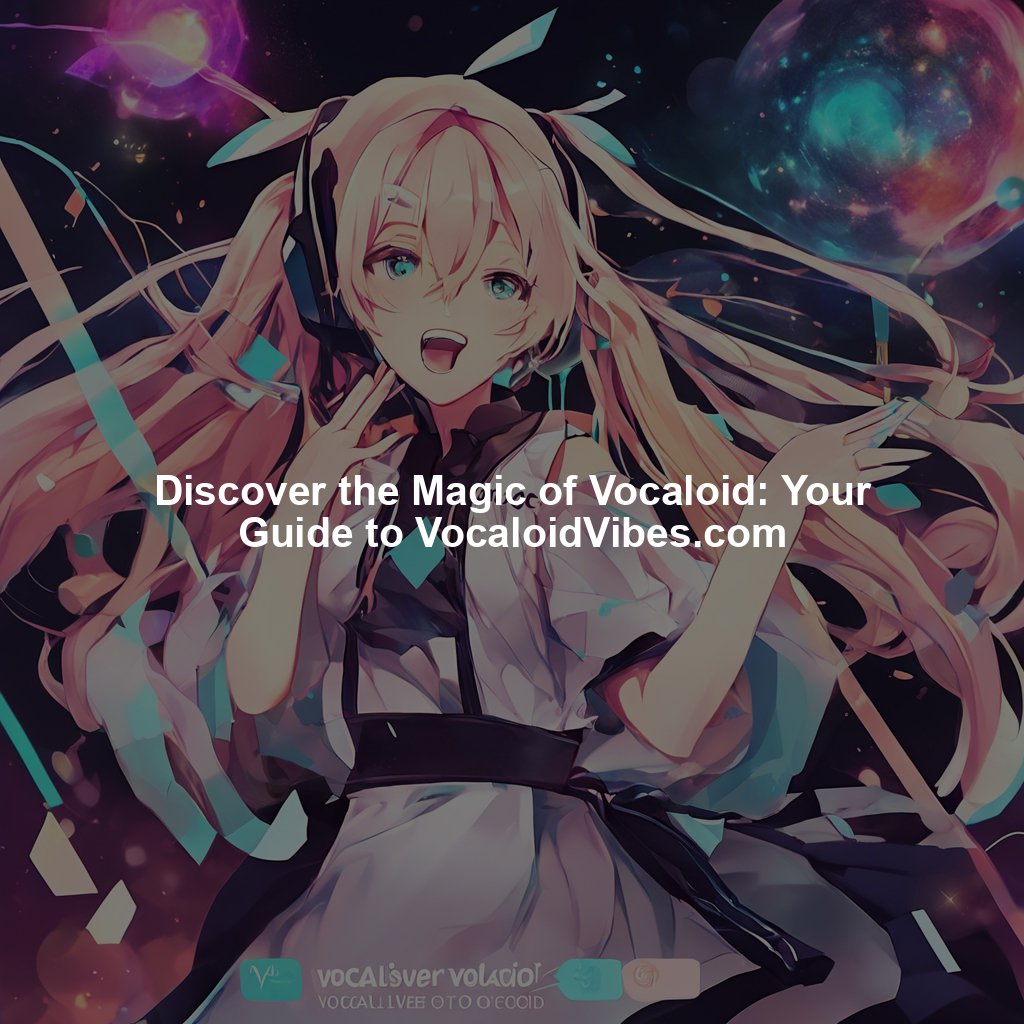Curious about becoming a Vocaloid music producer? It's easier than you think.
You can turn your passion for music into a reality. Vocaloid, a voice-synthesizing software, has revolutionized music production. It allows you to create songs using virtual singers. Aspiring producers can now bring their musical ideas to life without needing a human vocalist.
This guide will show you the basics of getting started. Learn about the tools, software, and steps needed to dive into the world of Vocaloid music production. Ready to create unique music? Let's explore how you can begin your journey as a Vocaloid music producer.

Credit: www.facebook.com
Introduction To Vocaloid
If you are passionate about music and love technology, becoming a Vocaloid music producer might be your dream job. Vocaloid is a unique software that allows you to create songs using synthesized voices. This blog post will guide you on how to get started.
What Is Vocaloid?
Vocaloid is a singing voice synthesizer software. It allows users to create music by typing in lyrics and melody. The software then generates a singing voice. Different characters, or voice banks, have different voices and styles. These characters can sing in various languages. You can adjust pitch, tone, and other vocal qualities. This gives you control over the final output.
History And Evolution
The history of Vocaloid began in 2000. The Yamaha Corporation developed it. They released the first version in 2004. The early versions had limited capabilities. Over the years, Vocaloid has evolved significantly. New versions offer more realistic and flexible voices. It has become popular in various music genres.
Here is a brief timeline of Vocaloid's evolution:
- 2004: Vocaloid 1 released
- 2007: Vocaloid 2 released with improved voice quality
- 2011: Vocaloid 3 introduced multi-language support
- 2014: Vocaloid 4 added growl and cross-synthesis features
- 2018: Vocaloid 5 offered enhanced editing tools
Today, Vocaloid is used by both amateurs and professional music producers. It has a large community and numerous tutorials available online. Getting started as a Vocaloid music producer is easier than ever before.
Choosing Your Vocaloid Software
Choosing the right Vocaloid software is a crucial step for new producers. The software you select will shape your music production experience. It will also affect the quality of your final tracks. Let's explore the options and factors to consider.
Popular Vocaloid Software Options
There are several popular Vocaloid software options on the market. Each has unique features and strengths. Here are some top choices to consider:
- Vocaloid 5: Known for its user-friendly interface and flexible tools.
- Piapro Studio: Offers integration with Crypton Future Media's virtual singers.
- CeVIO Creative Studio: Provides advanced voice synthesis and editing options.
Factors To Consider
Several factors can influence your choice of Vocaloid software. Start by considering your budget. Some software options are more affordable than others. Next, think about the ease of use. If you're new, a user-friendly interface can make a big difference.
Compatibility is another important factor. Ensure the software works with your computer's operating system. Also, check if it integrates well with your Digital Audio Workstation (DAW).
Finally, consider the available voice banks. Different software offers different vocal styles and languages. Choose one that suits your music genre and target audience.
Essential Equipment
Essential equipment is crucial for anyone starting as a Vocaloid music producer. Quality gear ensures your music sounds professional. Here’s what you need to begin your journey.
Computer Specifications
A powerful computer is your starting point. It should handle music production software smoothly. Look for a machine with at least 16GB of RAM. A fast processor, like an Intel i7 or better, is important. You also need ample storage. An SSD of 512GB or more works best. This ensures quick access to your files. Don’t forget a good graphics card. It helps run your software without lag.
Audio Interface And Microphone
An audio interface is essential. It connects your microphone and instruments to your computer. Focusrite Scarlett 2i2 is a popular choice. It offers excellent sound quality. You also need a good microphone. The Audio-Technica AT2020 is affordable and reliable. It captures clear vocals, which is key for Vocaloid music. Don’t forget a pop filter. It reduces unwanted noise, ensuring cleaner recordings.
Setting Up Your Studio
Starting as a Vocaloid music producer can be thrilling. The first step is setting up your studio. A well-organized and acoustically treated space is crucial. It helps you create high-quality music and makes the process enjoyable.
Acoustic Treatment
Acoustic treatment is essential. It reduces unwanted sounds and echoes. This makes your recordings clearer and more professional. Here are a few tips:
- Use acoustic panels on your walls. They absorb excess sound.
- Consider bass traps in corners. They manage low-frequency sounds.
- Place diffusers strategically. They help scatter sound evenly.
Remember, you don’t need to treat the entire room. Focus on key areas like walls and corners. This will make a big difference in sound quality.
Organizing Your Workspace
An organized workspace boosts productivity. You’ll work more efficiently and creatively. Here’s how to set up your space:
- Desk Setup: Keep your desk tidy. Place your computer, MIDI keyboard, and other equipment within easy reach.
- Cable Management: Use cable ties or organizers. This prevents tangling and keeps your area neat.
- Storage Solutions: Use shelves or drawers for storing small items. Keep your software, interfaces, and accessories organized.
Creating a clean and organized workspace helps you stay focused. It also makes it easier to find what you need, saving you time and reducing stress.
| Item | Description |
|---|---|
| Acoustic Panels | Absorbs excess sound and reduces echoes. |
| Bass Traps | Manages low-frequency sounds in corners. |
| Diffusers | Scatters sound evenly for better distribution. |
With these tips, you’re on your way to creating a functional and inspiring studio. Happy producing!
Learning The Basics
Learning the basics is the first step to becoming a Vocaloid music producer. This involves understanding the software and tools you'll use. You need to navigate through complex systems and terms. Let's break it down into simpler parts.
Navigating The Software
Start by familiarizing yourself with the Vocaloid software interface. Explore the menu options and tools available. Watch tutorials to learn how to use each feature. Practice makes perfect, so spend time experimenting with different settings.
Understanding Midi And Daws
MIDI stands for Musical Instrument Digital Interface. It's a protocol that allows electronic instruments and computers to communicate. Learn how to use MIDI to create and edit music. Digital Audio Workstations (DAWs) are software used for recording, mixing, and producing audio files. Popular DAWs include FL Studio, Ableton Live, and Logic Pro. Choose one that suits your needs and learn its features.
Understanding the basics of MIDI and DAWs will help you create better music. Spend time learning and practicing these skills. Soon, you'll be producing amazing Vocaloid tracks.
Creating Your First Track
Creating your first track as a Vocaloid music producer can be a thrilling experience. This journey involves composing melodies, programming Vocaloid vocals, and merging them into a cohesive piece. Let's dive into the steps to create your first track.
Composing Melodies
Start with a simple melody. Use a keyboard or a digital audio workstation (DAW). Experiment with different notes and rhythms. Keep the melody catchy and easy to remember. Don’t worry about complexity at first. Focus on creating something that sounds good.
Once you have a basic melody, add chords. Chords give your melody depth and emotion. Play around with different chord progressions. Find one that complements your melody well. Keep refining until you’re happy with the result.
Programming Vocaloid Vocals
Now it’s time to program the Vocaloid vocals. Open your Vocaloid software and import your melody. Choose a Vocaloid voice that fits your track’s mood. Type the lyrics into the software. Make sure the words match the melody’s rhythm.
Adjust the pitch and timing of each note. This makes the vocals sound more natural. You can also add vibrato and dynamics. These effects add expression to the vocals. Keep tweaking until the vocals blend well with your melody.
Mixing And Mastering
Mixing and mastering are crucial steps in producing high-quality Vocaloid music. These processes ensure your track sounds polished and professional. Mixing balances the individual elements, while mastering fine-tunes the final product. Let's dive into the basics to help you get started.
Basic Mixing Techniques
Start by adjusting the volume levels of each track. Ensure every element can be heard clearly. Use EQ to shape the sound of each track. Cut unwanted frequencies and boost those that enhance the track. Panning helps to create a sense of space. Place different elements across the stereo field. This makes the mix sound wider.
Add effects like reverb and delay. These effects can give depth and space to your mix. Use compression to control the dynamics. It ensures no part of the mix is too loud or too soft. Listen to your mix on different speakers. This helps you identify and fix any issues.
Finalizing Your Track
Once the mix sounds balanced, it's time to master the track. Start with EQ to fine-tune the overall sound. Make sure the track sounds consistent across different playback systems. Use compression to glue the mix together. It adds cohesion and makes the track sound unified.
Limiters help to increase the overall volume without causing distortion. Be careful not to overdo it. Loudness is important, but clarity is key. Listen to your mastered track in different environments. This ensures it sounds good everywhere. Finally, export your track in a high-quality format. Your Vocaloid music is now ready for the world to hear.

Credit: www.vocaloid.com
Promoting Your Music
Once you've created your Vocaloid tracks, the next step is to promote your music. This involves sharing your creations with the world and building a fanbase. The internet offers a variety of tools and platforms to help you achieve this.
Building An Online Presence
Start by creating profiles on popular social media platforms. Use Facebook, Twitter, and Instagram to share updates and snippets of your music. Create a YouTube channel to upload full tracks and music videos. Having a consistent presence on these platforms is crucial.
Make sure your profiles are visually appealing. Use a professional profile picture and cover photo. Write a clear and engaging bio that tells people about your music and what makes you unique. Share regular updates and engage with your followers.
Engaging With The Community
Being active in the Vocaloid community can significantly boost your visibility. Join forums and groups where Vocaloid fans and producers interact. Share your music and participate in discussions. This can help you gain feedback and connect with other producers.
Consider collaborating with other Vocaloid artists. This can introduce your music to their audience, and vice versa. Participate in Vocaloid contests and events. These can provide exposure and help you network with industry professionals.
Summary
Promoting your music involves building an online presence and engaging with the community. Use social media and YouTube to share your music. Join Vocaloid forums and collaborate with other artists. Participate in contests to gain exposure. By doing so, you can build a fanbase and share your music with the world.
Resources For Further Learning
Starting as a Vocaloid music producer can be exciting and overwhelming. Accessing the right resources is key to progress. Here, we provide some essential resources for further learning.
Online Tutorials And Courses
Online tutorials and courses offer a great way to learn. Websites like Udemy and Coursera provide structured lessons. They cover basics and advanced techniques. YouTube also has many free tutorials. Channels like Vocaloid Master and Vocaloid Tutorials are very helpful.
These platforms offer a range of teaching styles. Some focus on specific software. Others cover general music production tips. Choose ones that suit your learning style and needs.
Books And Guides
Books and guides can be excellent resources. They offer in-depth knowledge and tips. The Complete Guide to Vocaloid” is a popular choice. It covers everything from software setup to advanced production techniques.
Another good book is “Vocaloid Music Production Secrets.” It provides practical advice and insider tips. Guides like these can help you understand complex topics. They also offer step-by-step instructions to improve your skills.

Credit: www.instagram.com
Frequently Asked Questions
What Equipment Do I Need To Start?
To start as a Vocaloid music producer, you need a computer, DAW software, Vocaloid software, and a good microphone.
How Do I Choose A Vocaloid Voicebank?
Choose a Vocaloid voicebank based on your desired music style. Listen to samples and read reviews.
Can I Use Free Software To Produce Vocaloid Music?
Yes, you can use free DAWs and trial versions of Vocaloid software to get started.
What Skills Are Essential For Vocaloid Music Production?
Essential skills include basic music theory, audio editing, and familiarity with DAW software and Vocaloid programming.
Conclusion
Starting as a Vocaloid music producer can be exciting. Experiment with different sounds. Use the tips shared in this guide. Keep practicing and learning. Join online communities for support. Never stop creating new music. Over time, you will improve. Enjoy the journey and have fun.
Your unique style will shine through. Happy producing!









